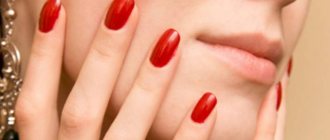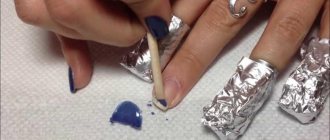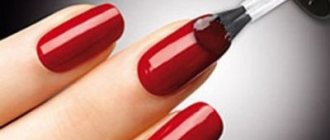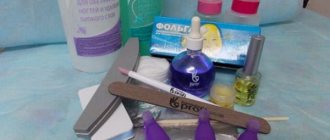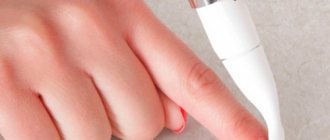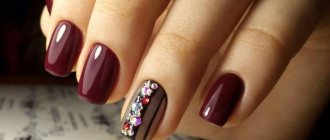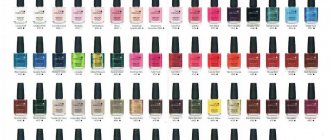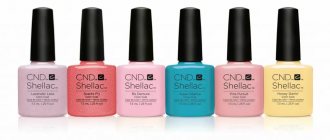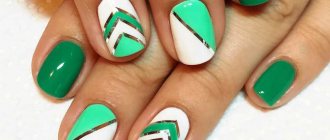In the modern world, women of any age spend a lot of time on self-development, improvement, learning new things, but at the same time do not forget to find a few minutes a day for self-care. Any girl always wants to look great and please herself first and foremost. Most tasks are done by hand, which means they are always visible and should look neat and well-groomed. One way to make a manicure beautiful and practical is to apply shellac, but you need to know whether it is harmful to nails.
Modern shellac
Shellac is an excellent alternative to regular polish, which was created for those who want to try to constantly maintain a beautiful appearance of their nails. This coating consists of two products: the previously common regular varnish and a special modeling gel.
“By inheritance” from simple varnish, shellac was given the method of application, a huge color palette and the type of coating itself.
And the gel provides such an irreplaceable advantage as long-lasting durability. Shellac coating, or otherwise called gel polish, lasts on the nail plates for about three weeks in its original form, and with very careful use this period can be a whole month. Only the areas of the nail that grow at the base can give away how long a manicure will last.
Applying shellac is a little more difficult than a regular coating, so most often a manicure is done in special nail design studios or beauty salons, which include this type of manicure at home, which is impossible without special equipment, namely an ultraviolet lamp.
One of the most important stages is polishing the nail plate, which allows you to make it absolutely smooth, without various “bumps” and excess skin. A perfectly flat surface is the key to strong adhesion of the base and polish to the nail.
Read also Damage from organophosphorus compounds (OPCs)
The next very important stage is degreasing; only after this can the base coat be applied. Its function is to protect the nail from the harmful effects of pigments in the color layer. Following the base, a color coating is applied, usually in 2-3 layers.
The main difference between shellac and regular varnish is drying the nail for two minutes after each layer under a special ultraviolet (less often LED) lamp. Thus, the coating is firmly fixed. With this drying, the shellac dries completely, and you don’t have to worry about the coating smearing or any random inclusions remaining on it. In total, it will take about an hour to cover all nails.
What could be harmful to health?
We often hear that according to experts, shellac for nails is harmful. The following facts are presented as evidence:
- Preparatory polishing of nails is one of the reasons why shellac is harmful. The plates become brittle and peel off greatly.
- Drying of nails is carried out using special lamps. According to doctors, it is not so much shellac itself that is harmful to nails, but ultraviolet radiation. It causes skin cancer in humans.
- To remove the plate, it is treated with a special liquid. It contains acetone, which makes shellac harmful to nails.
- Instead of expensive material, there is a risk of buying a fake. It may contain toxic substances and cause allergies.
- Damage to shellac nails is caused by fumes that inevitably occur during the procedure.
Speaking about whether shellac is always harmful for nails, experts warn about some contraindications. Doctors and nail salons recommend refraining from such application if:
- pregnancy; Shellac is especially harmful in the first months - a woman’s body at this time can react unpredictably even to familiar materials and cosmetics;
- increased brittleness of nails and very thin plates;
- fungal infections - the disease must first be cured;
- taking certain medications.
Restrictions in many cases are related to the general health condition and individual characteristics of the woman.
Damage to the nail plate
The process of applying the gel itself involves light polishing of the nail. This, of course, makes it somewhat thinner. Therefore, if you use shellac too often, the nail will deteriorate and become thinner. In this case, it will not bring any benefit. However, there are still many nuances that should be considered in order to really understand whether gel polish is so harmful for the nail plate:
- Shellac cannot be called the most harmless coating method. The harm lies not so much in the grinding, but in the application technique itself. The very first layer - the base - is used to evenly distribute the color over the nail.
The next, no less important, function is to ensure that the gel polish does not peel off over time and does not chip during wear. To do this, allow the gel to penetrate into the uneven, slightly damaged surface of the nail plate, thereby gluing it together. This can be attributed to the second indicator of the harmfulness of the procedure.- There is another point that causes controversy - this is the process of drying shellac. Scientists studying this issue claim that the ultraviolet lamp, which is used by craftsmen to dry each layer of coating, is dangerous to women's health. This conclusion was recently made by specialists from an American organization that deals with skin cancer problems. Research in this direction shows that devices used in beauty salons can have a carcinogenic effect. Still, you need to understand that the risk of getting sick is very small, but you shouldn’t write it off completely.
- It should also be noted that the gel polish coating is quite durable and masks all possible inflammatory processes that could theoretically develop under the nail plate.
- It is not prohibited to do manicure during pregnancy. But before the procedure, you must carefully study the composition of the shellac product. You should avoid any composition that mentions camphor oil. This substance provokes increased tone of the uterus, which adversely affects the condition of the fetus.
Read also Mercury vapor poisoning: causes, first aid, prevention
It is impossible to say accurately and unconditionally whether shellac spoils nails, but in any case they must be protected, and any coating, if used correctly, will significantly reduce the negative consequences.
What else is harmful about gel polish: UV lamps and improper cutting
Due to the fact that nails grow quite quickly, it is necessary to adjust the manicure at least 2 times a month. Therefore, we invite you to get to know the “helpers” of gel polish better.
Nail polish removal technique and possible consequences
- Don’t be alarmed, this does not mean that the procedure is contraindicated for everyone or will cause any negative nuances. We are talking specifically about poor-quality or even incorrect cutting and removal of the varnish itself.
- If you diligently remove gel polish (and it doesn’t matter whether this is done with a Fraser or other tools), you can damage the protective film of the nail. Then the manicure will not only be untidy, but will entail all the above-mentioned negative aspects.
- If, when peeling off the varnish, you decide to pull off this piece, then be prepared that with it you will tear off part of the upper scales of your own nail.
- When scraping with sharp objects, you can scratch the top layer, thereby causing peeling of entire nail plates.
- And a few words about preliminary removal of the top layer of the nail. Sometimes incompetent nail technicians clean the nail too much. This also damages the protective layer and spoils the nails themselves.
- Also, special attention concerns the files themselves. We strongly recommend that for natural nails you choose files no more than 240 grit. And then, this is to adjust the form itself. A hard file will cause delamination.
- But for polishing you need to take buffs with a hardness of no higher than 900 grit, or even better – 400.
What about the UV lamp?
- Of course, an ultraviolet lamp cannot be called sinless. But it is worth recalling that other technologies also “reward” us with radioactive or ultraviolet radiation. But we use them.
- Moreover, contact with such rays does not last long enough to cause the formation of cancer cells in the body. You wouldn't expose yourself to a lamp every day. And once a month will not bring negative consequences. By the way, LED lamps are less dangerous and dry the varnish in 10-30 seconds. Therefore, they further minimize the harmful effects of ultraviolet radiation.
- But it is still worth considering some recommendations so as not to put yourself at risk from a UV lamp: it is not recommended to dry it for ladies who have a large number of moles on their hands. It is also contraindicated for all those who have at least some wounds or even mosquito bites;
- To use a UV lamp, the master must have the appropriate certificates and certificates with a mandatory note of the characteristics of the equipment;
- It is believed that those lamps that come with the lowest indicator are less dangerous. But then the “baking” time of the varnish increases. Therefore, in the end there is no difference.
Important: To protect your hands from the harmful effects of ultraviolet radiation, wear special or even homemade fabric gloves while drying that only expose your fingertips. And don't forget to use sunscreen. You just need to apply it so as not to touch the nail plate.
It is advisable to apply a protective cream before drying in a lamp.
Frequency of use
There is no specific rule that regulates the frequency of shellac application. Most women wear this coverage without interruption, go for touch-ups every three weeks, are happy and have no problems.
If the nail begins to hurt, peel, feel discomfort and chips appear, then you should remove the coating and let the nails rest for a while. In just a month or two, your nails will return to their former shape, look healthy and beautiful.
If it is not possible to completely remove nail polish due to some circumstances, you can consider replacing the brand of base and color gels with another, more gentle composition.
If nothing bothers the owner of a beautiful manicure and there are no contraindications, then you can cover your nails with gel polish depending on her desire. Doing this often is not strictly prohibited; it all depends on the specific type of nail plate.
Pregnancy and the harm of gel polish: is it possible to do such a manicure?
The interesting position of a woman becomes the reason for increased sensitivity to most external influences that have at least some impact not only on themselves, but also on the growing baby.
- Of course, pregnant women cannot be refused and, if they wish, the use of shellac is allowed. But this must be done taking into account all, even minor rules, as well as with special caution and literacy.
- Before the procedure itself, it is necessary to apply a high-quality sunscreen to your hands, with an optimal SPF level of at least 30. It will significantly reduce the harmful effects of ultraviolet radiation.
- In no case should there be any toxic components in the composition of the varnishes used. All bottles must have the inscription “5 free”.
- It is better to alternate gel-based varnishes with simple enamels. But, ideally, it would be good to just leave your nails to rest.
- The process itself must be carried out in the fresh air, or in a well-ventilated room. This will significantly reduce the entry of harmful vapors into the body of a pregnant woman.
- In general, in this position you do not need to constantly wear a gel or even a regular coating. Of course, all women at any age and position want to look attractive and well-groomed. But due to hormonal changes, the nail plates already become dull and brittle, and you will also overload them with chemicals.
- Yes, sometimes this will help, on the contrary, to make your nails stronger while wearing the polish. But our advice is to use strengthening products to maintain your nails.
During pregnancy, it is better to avoid using gel polish.
Useful tips
Using shellac can be detrimental to your nail health. But it is, of course, possible to reduce the negative consequences.
To do this, you need to follow some recommendations:
- Before use, you should carefully study the composition of the product. It is undesirable to use low-quality products from unverified manufacturers. You should also check the quality certificate.
- During the shellac removal procedure, it is recommended to use orange wood sticks. Metal tools can severely damage the nail plate.
- Do not attempt to scrape or file away the coating yourself. Only a good master can do this correctly.
- After such a manicure, your nails need especially careful care. To do this, you can make masks and baths at home, rinse your hands with decoctions of special medicinal herbs. You should also use a nourishing healing cream for hands, nails and cuticles.
Read also Domestic gas in the house: what is the danger of a leak, help with suffocation
If you follow these simple recommendations, your manicure will delight you without harming your health. However, if suddenly the body shows a strong allergic reaction to gel polish, which is confirmed by the doctor, it is still better to abandon it forever and try some other nail coating methods.
The consequences of shellac rarely leave negative impressions on women, since the beauty, durability and practicality of the coating bring only joy.
There are pros and cons to any type of coating, be it regular varnish, shellac, or artificial tip extensions. Every girl who wants to be beautiful knows how to paint her nails from childhood, but how and with what to do it needs to be decided individually. Obviously, with proper use, careful wear and thanks to good nail technicians, damage to nails can be minimized.
In the salon or at home?
Many people have doubts: is shellac a varnish or a gel coating? In fact, neither one nor the other. Shellac is a gel polish, not even a gel polish. The innovative formula of the gel polish gives signature shine, reliability, hardness and quality. Unlike gel polishes, the percentage of varnish in shellac is higher. In general, shellac is just the name of the product.
Creative Nail Design has developed and released a unique nail product under this name. Having gained incredible success, shellac soon became a household name. In fact, this is just a representative of a group of gel polishes from a specific manufacturer.
Fashionistas all over the world are interested in whether it is possible to apply the coating outside the walls of a beauty salon? Theoretically, yes: buy the tools, learn everything about how to properly paint your nails with shellac, get your hands on the ball. Reviews confirm that even in practice this is real. Many have independently mastered this process without taking specialized courses.
However, experts strongly recommend that you apply for a manicure with gel polish exclusively to a specialist. Mistakes in applying and/or removing shellac can have negative consequences. The key to success is strict adherence to patented technology.
It is important to carry out competent preparatory actions, step-by-step follow the instructions for coating the nail plates, know the rules for removing manicure, etc. Or, instead of the stated 14 days, you may end up with chipping and swelling after just a couple of days. In addition, you will harm the nail plates instead of strengthening them.
Advantages and disadvantages
Pros, how long does it last?
The first thing to note is the durability of shellac.
A properly applied coating, following all recommendations and steps, will last at least two weeks - without peeling or slipping of the material.
The coating is so hard that even a noticeable mechanical impact does not leave marks on it.
The coating has a very beautiful shine. That is why shellac can give an elegant look to any nails. This is the perfect holiday manicure.
Shellac is a gentle coating, as it does not require cutting when preparing the plate and when removing it. This is a very important advantage, since it is mechanical filing that so often leads to thinning of the nail plate during extensions.
The composition of the product is safe. There are no aggressive substances: toluene, formaldehyde, etc. Even with frequent use, shellac will not harm your nails. But from time to time it is still recommended to take a “break”.
It is also important that even pregnant women can safely wear beautiful nails coated with shellac. The product will not harm the baby either during pregnancy or during breastfeeding.
Shellac protects the nail, creating a kind of “blanket” on its surface. Under the cover of such protection, the plates usually begin to grow rapidly, so you can easily get long nails using shellac. Under the coating, the plate does not peel off or crack.
The decorative properties of shellac deserve special attention. The unique gel consistency and the richest palette of shades allow you to choose a coating for any occasion, to suit any outfit. And additional decor - sparkles, rhinestones, painting, etc. will make the final result even more elegant and catchy. Such nails will definitely not leave their owner without attention.
Shellac dries instantly in a UV lamp, so there is no risk that the coating will smudge. It does not have an unpleasant odor, so application does not cause discomfort.
Here is a review of Navel Lengthening and Curling Mascara.
Minuses
Having talked about the advantages, it is necessary to dwell on the existing disadvantages.
Despite the gentle properties of this coating, it still cannot be called beneficial for nails. If used frequently, shellac will also not have a beneficial effect on the condition of the plate; it can cause it to become weak and thin.
This is why it is recommended to take breaks and not wear shellac all the time.
To properly apply shellac, you need to purchase a lot of products, as well as a special lamp. Perhaps it would be more logical to visit a specialist, otherwise you might be wasting your money. In addition, the master is guaranteed to do everything correctly, and the coating will last the required time.
Shellac requires regular correction, as the overgrown coating looks unsightly. Correction will have to be done at least once every two weeks. And these are also costs - time and financial.
Check out reviews of navel eyeshadows.
If your nails are thin, weak, deformed and prone to peeling, shellac will not stick well to them.
Sometimes after just a few days you can notice the first detachments at the cuticle, which will continue to increase. But on strong, strong nails the material holds up great.
This coating is sensitive to temperature changes. If you jump out of your apartment into the cold without gloves in winter, the shellac may soon crack.
If material detachments appear, the space between the coating and the nail becomes a suitable breeding ground for the proliferation of a wide variety of microorganisms.
In a warm and humid environment, fungus can develop, and sometimes even mold appears. Therefore, it is important to deal with them immediately when detachments appear.
Contraindications
Who should not apply shellac
- For fungal nail diseases, it is prohibited to perform any procedures other than therapeutic ones. Including shellac.
- During pregnancy, the procedure should be approached with caution. Sometimes material detachments occur due to a woman’s increased hormonal levels.
- Diabetes mellitus, again due to hormones, can also cause detachments.
Look at the photo of Pup's blush.
What you need for coverage and extensions
Let's consider what products, tools and equipment are needed to apply shellac.
Ultraviolet lamp for shellac. You simply can’t go anywhere without this item. A 9 W lamp is also suitable for home use, while in beauty salons they use a 32 W lamp. Actually, shellac itself. Three-phase is better, it consists of a transparent base with a finish and a colored component. If the base and topcoat are the same each time, then there can be as many colored bottles as you like. Buy your favorite shades and enjoy beautiful nails. In addition to the above, you will also need consumables. This:
- cotton pads;
- files;
- nail oil;
- liquid for removing shellac, gel polish;
- primer (if the technology provides for it);
- orange stick;
- manicure tools: scissors, pusher, tweezers;
- degreaser.
Video about the differences between shellac and nail extensions
Watch the video on how to apply false eyelashes to yourself.
Features of applying varnish - how to use it correctly
How to apply shellac yourself.
Before starting the procedure, remove the old nail polish, do a hygienic manicure, and shape your nails with a nail file. When performing a manicure, you must use gel to remove the cuticle. This will make the procedure easier.
After your manicure, take a nail file and remove the shine from the nail plate. Do this without fanaticism, carefully so as not to damage your nails. When the plate has become matte, it is ready to interact with shellac. Its slightly rough surface will be much better able to adhere to artificial material.
Degrease the surface of the nails with a special solution, which is called that way. This procedure will help the artificial coating to “stick” more firmly to the natural nail and ensure adhesion. If the procedure involves the use of a primer or bonder, then after degreasing, apply a drop of this drug to the plate. Not everyone knows what a shellac primer is for. It provides even better adhesion to the nail and eliminates the possibility of detachments.
Apply a clear base coat first. This is done in a thin layer. Be sure to seal the ends of the nails to prevent possible detachments of the material. After application, dry each nail for a minute in a lamp.
Features of applying shellac.
Be careful: sometimes when drying your nails in a lamp, especially if this is not the first procedure, you may feel quite a burning sensation on the plate. This happens if the nails are naturally very thin and soft or if a layer of shellac is applied too thick. If a burning sensation occurs, you need to remove your hand from the lamp for 2 seconds and place it there again.
The second step is to apply colored shellac. Attention: the color is usually applied in two layers, as this provides a better result and a more saturated shade. The end in this case is not sealed. Dry your nails in a lamp as you apply.
The final stage is the application of the finishing coat. It is also transparent, and when applying it you need to seal the end. The finishing coat is like a mirror, making nails ultra-shiny and hard and durable.
Video instructions for applying shellac at home
After all your nails are thoroughly dry, take some special oil and rub it into the cuticle area. This simple technique protects your nails, ensures their health, good growth and strong cuticles.
Preparing nails for application
No one will dispute that the gel extension procedure has an extremely negative effect on nails. And although, judging by the composition, Shi polish is still not the same as gel polish, it is still quite harmful to nails. Therefore, for the procedure of applying it, you need to prepare your nails as carefully as for extensions. The same applies to caring for the plates after removing the coating.
Shellac coating
- If your nails are dry and weak, then they need to be moisturized and strengthened, both before applying shellac and after removing it. The easiest way to do this is with the help of special masks that do not contain calcium. It is good to use products that contain aloe, chamomile, keratin, glycerin;
- If you still decide to apply shellac, regardless of whether it is harmful or not, then before the procedure it is also recommended to nourish your nails with calcium. Especially if you have previously noticed brittleness and layering of your nails, which indicate a lack of this element. A week before applying shellac, it is recommended to start regularly using special bases for varnish. While wearing the covering and for some time after removing it, consume the largest amount of vitamins D3 and B5 and calcium in your food. Various vitamin complexes sold in pharmacies will help with this;
- If the nails are very peeling, it is better to start treatment with local preparations containing active fruit acids. They will be able to enrich your nails with useful substances and strengthen them. After removing the shellac, you can seal it with wax.
However, shellac or gel polish spoils such nails to the greatest extent, and therefore the use of such coatings is highly not recommended for this problem.
